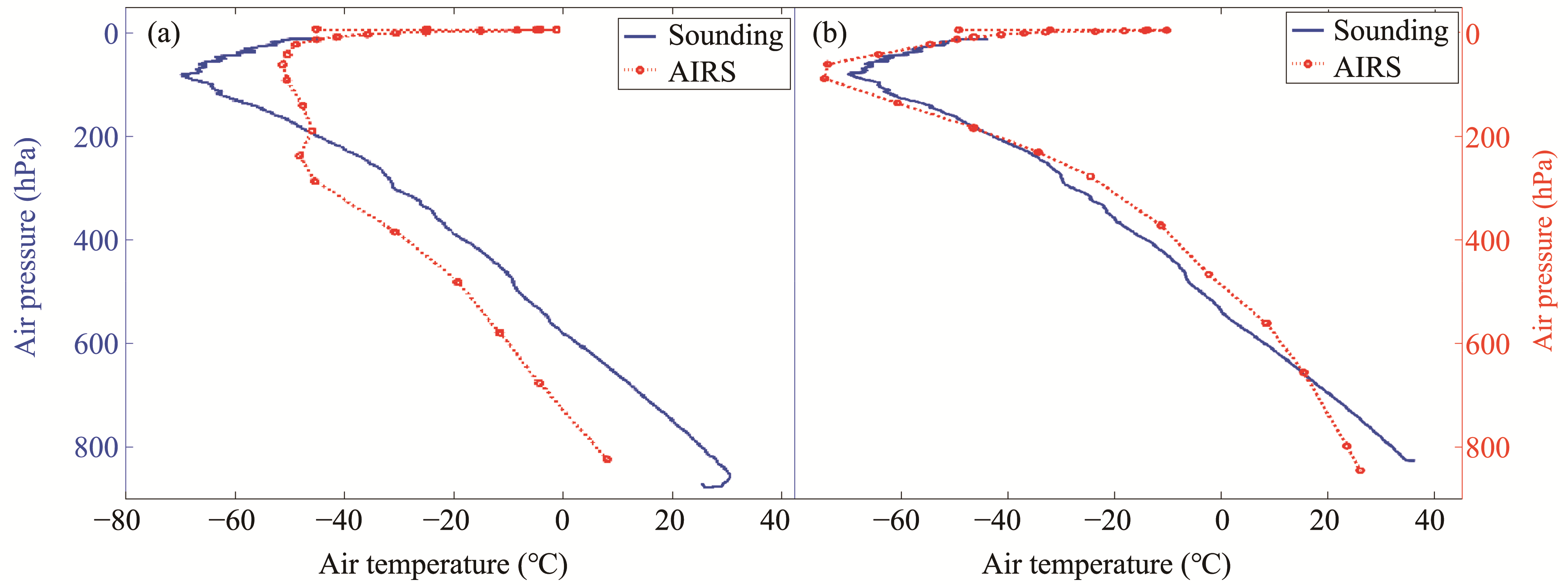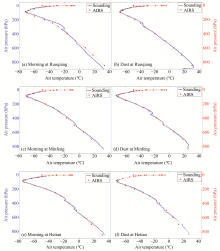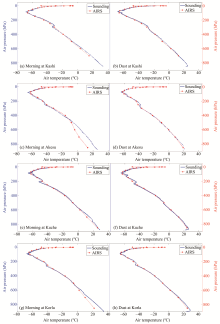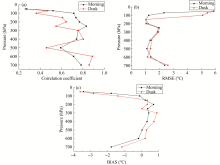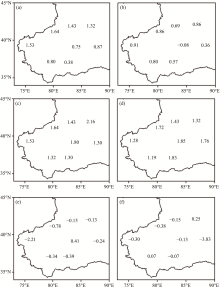Sciences in Cold and Arid Regions ›› 2020, Vol. 12 ›› Issue (4): 242–251.doi: 10.3724/SP.J.1226.2020.00242
• • 上一篇
Validation of AIRS-Retrieved atmospheric temperature data over the Taklimakan Desert
YuFen Ma1,2,RuQi Li3,Men Zhang3,MinZhong Wang1,2,Mamtimin Ali1,2( )
)
- 1.Institute of Desert Meteorology, China Meteorological Administration, Urumqi, Xinjiang 830002, China
2.Center of Central Asia Atmospheric Science Research, Urumqi, Xinjiang 830002, China
3.Xinjiang Meteorological Observatory, Urumqi, Xinjiang 830002, China
|
Aumann HH, Chahine MT, Gautier C, et al., 2003. AIRS/AMSU/HSB on the Aqua mission: design, science objectives, data products, and processing systems. IEEE Transactions on Geoscience & Remote Sensing, 41(2): 253-264. DOI: 10.1109/TGRS.2002.808356.
doi: 10.1109/TGRS.2002.808356 |
|
| Dong CH, Li J, Zhang P, 2013. Principle and Application of Satellite Hyperspectral Infrared Atmospheric Remote Sensing. Science Press, pp. 69-113. | |
|
Fetzer EJ, Read WG, Waliser D, et al., 2008. Comparison of upper tropospheric water vapor observations from the Microwave Limb Sounder and Atmospheric Infrared Sounder. Journal of Geophysical Research Atmospheres, 113(D22):1971-1976. DOI: 10.1029/2008JD010000.
doi: 10.1029/2008JD010000 |
|
|
Fredrick I, 1996. Validation of version 6 retrievals of AIRS temperature, water vapor and cloud data. Journal of Chromatography A, 719(1): 121-130. DOI: 10.1016/0021-9673(95)00326-6.
doi: 10.1016/0021-9673(95)00326-6 |
|
|
Gettelman A, Weinstock EM, Fetzer EJ, et al., 2004. Validation of Aqua satellite data in the upper troposphere and lower stratosphere with in situ aircraft instruments. Geophysical Research Letters, 109(22): 359-393. DOI: 10.1029/2004GL020730.
doi: 10.1029/2004GL020730 |
|
|
Kim M, Kim HM, Kim JW, et al., 2017. Effect of enhanced satellite-derived atmospheric motion vectors on numerical weather prediction in East Asia using an adjoint-based observation impact method. Weather & Forecasting, 32(2): 579-594. DOI: 10.1175/WAF-D-16-0061.1.
doi: 10.1175/WAF-D-16-0061.1 |
|
| Li JF, 1991. Climate in Xinjiang. Meteorological Press, pp. 15-153. | |
|
Liu H, Dong CH, Zhang WJ, et al., 2008. Retrieval of clear-air atmospheric temperature profiles using AIRS observations. Acta Meteorological Sinica, 66(4): 513-519. DOI: 10.3321/j.issn:0577-6619.2008.04.004.
doi: 10.3321/j.issn:0577-6619.2008.04.004 |
|
|
Liu YQ, Ali M, Wen H, et al., 2016. Nondimensional wind and temperature profiles in the atmospheric surface layer over the Hinterland of the Taklimakan Desert in China. Advances in Meteorology, 2016: 1-8. DOI: 10.1155/2016/9325953.
doi: 10.1155/2016/9325953 |
|
|
Parkinson CL, 2003. Aqua: an Earth-Observing satellite mission to examine water and other climate variables. IEEE Transactions on Geoscience & Remote Sensing, 41(2): 173-183. DOI: 10.1109/TGRS.2002.808319.
doi: 10.1109/TGRS.2002.808319 |
|
|
Sertel E, Robock A, Ormeci C, 2010. Impacts of land cover data quality on regional climate simulations. International Journal of Climate, 30(13): 1942-1953. DOI: 10.1002/joc. 2036.
doi: 10.1002/joc. 2036 |
|
|
Susskind J, Barnet CD, Blaisdell JM, 2003. Retrieval of atmospheric and surface parameters from AIRS/AMSU/HSB data in the presence of clouds. IEEE Transactions on Geoscience & Remote Sensing, 41(2): 390-409. DOI: 10.1109/TGRS.2002.808236.
doi: 10.1109/TGRS.2002.808236 |
|
|
Wang M, Wei W, He Q, et al., 2016. Summer atmospheric boundary layer structure in the hinterland of Taklimakan Desert, China. Journal of Arid Land, 8(6): 1-15. DOI: 10. 1007/s40333-016-0054-3.
doi: 10. 1007/s40333-016-0054-3 |
|
|
Wang MZ, Wei WS, Wei G, et al., 2014. Detection study of dust weather and clear air turbulence in the Hinterland of the Taklimakan Desert using a Wind profiling Radar. Remote Sensing Technology and Application, 29(04): 581-586. DOI: 10.11873/j.issn.1004-0323.2014.4.0581.
doi: 10.11873/j.issn.1004-0323.2014.4.0581 |
|
|
Wang N, Li ZL, Tang BH, et al., 2013. Retrieval of atmospheric and land surface parameters from satellite-based thermal infrared hyperspectral data using a neural network technique. International Journal of Remote Sensing, 34(9-10): 3485-3502. DOI: 10.1080/01431161.2012.716536.
doi: 10.1080/01431161.2012.716536 |
|
|
Yang Q, Wei WS, Li J, 2008. Temporal and spatial variation of atmospheric water vapor in the Taklimakan Desert and its surrounding areas. Chinese Science Bulletin, 53(2): 71-78. DOI: 10.1007/s11434-008-6007-2.
doi: 10.1007/s11434-008-6007-2 |
|
| Zhan RF, Li JP, 2008. Validation and characteristics of upper tropospheric water vapor over the Tibetan Plateau from AIRS Satellite Retrieval. Atmospheric Science, 32(2): 242-260. |
| No related articles found! |
|
||




